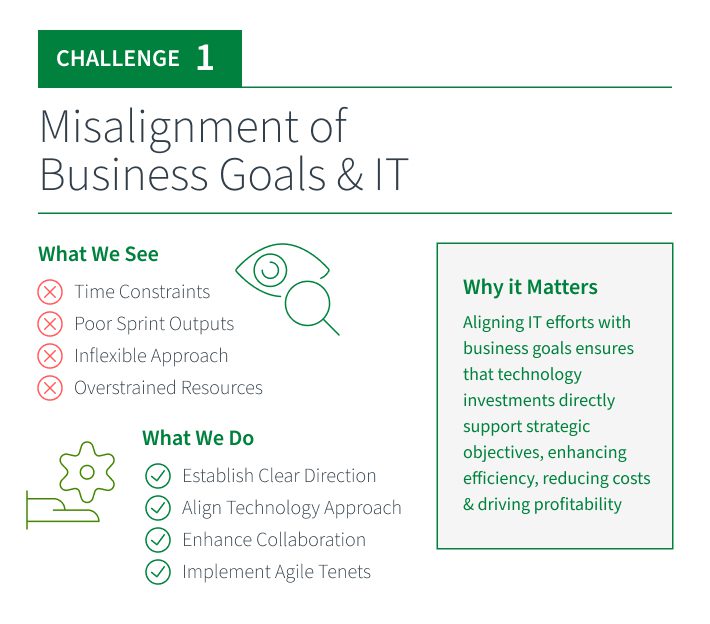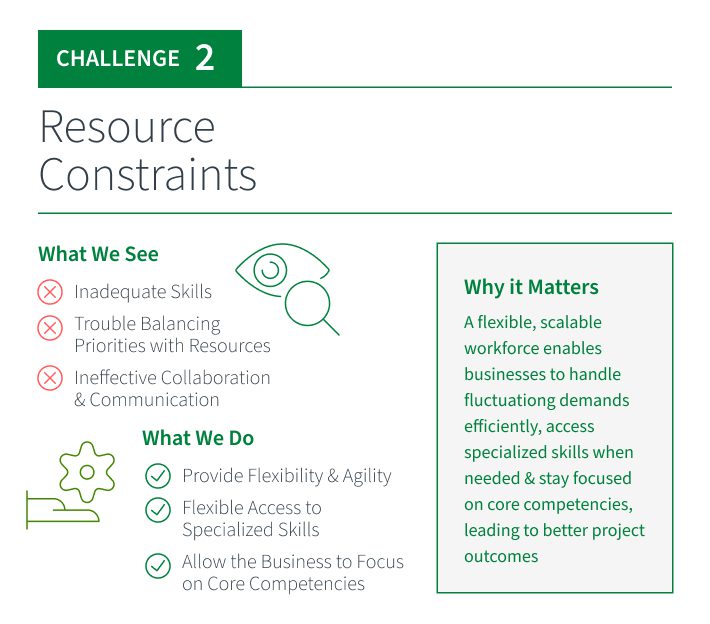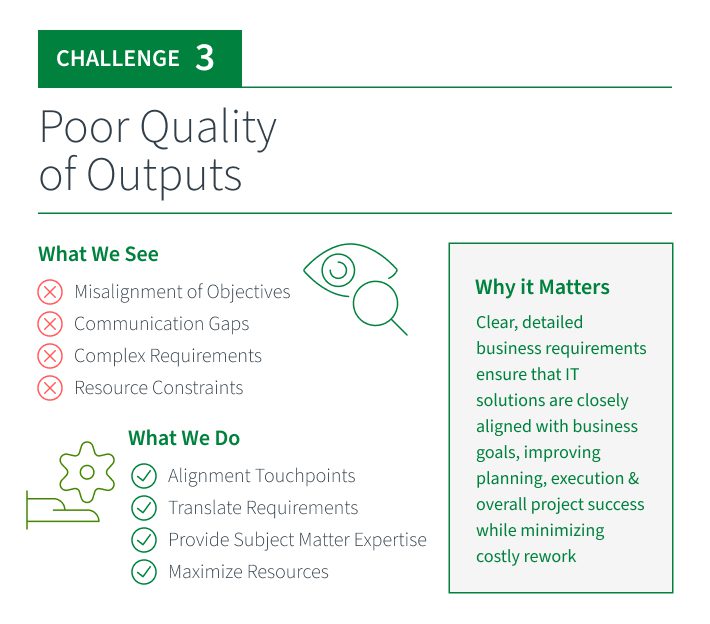Business Technology Enablement
Is your business trying to balance the pressures of resource constraints with the increasing need to meet technology demands and transformation initiatives?
Ventera’s Business Technology Enablement Offerings are designed to help businesses maximize their technology investments, resulting in a lower overall cost of ownership.
Our experts understand that business needs can change rapidly. That’s why we provide our clients with scalable teams that work closely with your product owner to build out the vision and the requirements to enable the development team. As the product is developed, our teams also manage the acceptance and integration with your users to ensure a successful adoption. This engagement ensures that the capital spent on strategic technology initiatives will always result in outcomes that drive the business’s bottom line and meet market and end-user needs.
Below are four challenges we commonly see when working with clients struggling to get the desired results from their IT investments, as well as some pointers on how to streamline this critical partnership.
1. Improving the output from technology teams to better align with business product owner expectations

What we see:
- Time Constraints: Business product owner teams don’t have the time to put into building out the details and thought leadership in the requirements such as epics and user stories sent to tech for
- Poor Sprint Outputs: Business teams don’t often inspect or manage the velocity or quality of technology outputs from sprint to sprint.
- Inflexible Approach: The approach isn’t regularly adjusted to account for long-term strategy or shifts in
- Overstrained Resources: Business teams are challenged to both manage the business area for which they are responsible AND serve as subject matter experts on technology initiatives to ensure those initiatives deliver the desired impact. This leads to:
- Incomplete requirements and lack of clear direction for developers
- Limited availability to inspect and manage project backlogs, manage team velocity or validate the quality of the technology delivered each sprint
- Demands on the business teams prevent regular adjustments to account for changes to the organization’s strategy or the technical landscape
What we do:
- Establish Clear Direction: Integrate skilled teams into product teams to manage the details and ensure the technology teams have no gray area.
- Align Technology Approach: Inspect outputs and work with leadership to adjust the technology approach to reflect recent tech industry advancements and fit long-term business
- Enhance Collaboration: Create transparency between business and technology teams so everyone is working off the same “story.”
- Implement Agile Tenets: Ventera embraces the fundamental Agile tenet of continuous business value delivery to users and stakeholders by utilizing a system of build and deploy. Our continuous refactoring model extends the initial investment in the software assets without a deprecated flow of value to the end users. Releasing in a series of iterative, incremental improvements enables the organization to continuously deliver code and component infrastructure while minimizing the impact on capacity and team velocity.
Why it matters:
Improving IT outputs to better align with the business vision is crucial for companies because it ensures that technology investments and initiatives directly support and drive the organization’s strategic goals. When IT systems and processes are closely integrated with the business vision, they enhance operational efficiency, streamline workflows, and enable more informed decision-making. This alignment not only helps in optimizing resource allocation but also significantly reduces the overall total cost of ownership of technology initiatives. By bridging the gap between technology and business objectives, companies can achieve better performance, greater customer satisfaction, and increased profitability.
2. Helping business teams scale to support strategic project work

What we see:
- Inadequate Skills: Projects require unique skills for relatively short periods of time, making it difficult to build teams with the proper skills.
- Trouble Balancing Priorities with Resources
- Ineffective Collaboration and Communication
What we do:
- Provide Flexibility and Agility: With scalable, accountable teams, businesses can quickly adapt to changing market conditions or project requirements. This agility is crucial for responding to new opportunities or challenges, implementing technological advancements, and adjusting strategies without being constrained by rigid, fixed
- Flexible Access to Specialized Skills: Our teams include members with specialized skills and expertise that may not be available in-house and are not required to be fully dedicated for the duration of the effort. This allows businesses to access cutting-edge technologies and knowledge, driving innovation and improving the quality of their technology initiatives without the long-term commitment of hiring permanent staff.
- Allow the Business to Focus on Core Competencies: The ability to quickly deploy teams to provide extra capacity for technology initiatives allows businesses to focus on their core competencies while outsourcing or sharing the responsibility for technical aspects. This can lead to better overall performance, as internal teams can concentrate on strategic priorities and value-driven activities rather than being bogged down by technical execution
Why it matters:
Having a flexible workforce to handle increased workloads and provide a variable skillset for technology projects offers businesses significant advantages by ensuring they can efficiently manage fluctuating demands without needing permanent hires. This approach allows companies to quickly scale their workforce and access specialized skills temporarily, aligning expertise with specific project needs and peak periods of activity. It enhances flexibility, enabling organizations to swiftly adapt to new challenges or technological advancements while controlling costs and minimizing risks associated with long-term commitments. It also provides the synergy of a team that has built a rapport working together cohesively on past projects rather than a group of individual contributors that will require additional management. Ultimately, this strategy helps businesses maintain productivity, drive innovation, and meet deadlines more effectively, all while focusing their core teams on strategic goals.
3. Translating business needs into an achievable technology solution

What we see:
- Misalignment of Objectives: One major problem is the misalignment between business objectives and technology When technological initiatives are not closely tied to business goals, there can be a disconnect between what the technology delivers and what the business needs, leading to ineffective or wasted investments.
- Communication Gaps: Effective communication between business stakeholders and IT teams is often a challenge. Misunderstandings or lack of clear, detailed requirements can result in technology solutions that do not fully address the needs or expectations of the business, leading to suboptimal outcomes.
- Complex Requirements: Businesses often have complex and evolving needs that are difficult to translate into technical specifications. This complexity can result in technology solutions that are either too simplistic or overly complicated, failing to effectively address the real business
- Resource Constraints: Limited resources, including budget, time, and skilled personnel, can make it challenging to develop and deploy technology solutions that meet business needs. Constraints can lead to compromises in the quality or scope of technology projects, impacting their ability to deliver the desired results.
What we do:
- Alignment Touchpoints: We facilitate workshops and strategic sessions to ensure that technology initiatives are closely aligned with business
- Translate Requirements: Ventera acts as an intermediary between business stakeholders and IT teams, translating business needs into clear, technical requirements. We facilitate communication and ensure that both parties understand each other’s language, leading to better-defined project scopes and more accurate technology solutions.
- Provide Subject Matter Expertise: Our teams include members with core industry knowledge and expertise in requirements gathering and We use structured methodologies to break down complex business needs into manageable components and translate them into well-defined technical specifications. Their experience helps in creating scalable solutions that can adapt to evolving business requirements.
- Maximize Resources: By leveraging their extensive knowledge and experience, our teams can help businesses maximize the use of available resources. We assist in project planning, prioritize initiatives based on resource constraints, and recommend best practices for efficient use of budget, time, and personnel, ensuring that technology projects are delivered on time and within scope.
Why it matters:
Improving the detail of the business needs for technology projects, including a strong epic and user story breakdown in the Agile process, is crucial for businesses because it ensures that technology solutions are precisely aligned with their strategic goals and user requirements. Detailed epics and user stories provide a clear and comprehensive understanding of what needs to be developed, reducing ambiguity and scope creep. This clarity facilitates better planning, prioritization, and execution, allowing IT teams to deliver solutions that meet or exceed expectations. It also enhances communication and collaboration between business stakeholders and development teams, leading to more effective and efficient project execution. By thoroughly defining business needs and breaking them down into actionable components, businesses can improve project outcomes, reduce the risk of costly rework, and ensure that technology investments drive meaningful value and achieve desired results.
4. Holding technology teams accountable to deliver quality solutions that are user-centric and align with modern technology architectures

What we see:
- Lack of Clear Requirements and Specifications: One major problem is the absence of well-defined requirements and project specifications. Without a clear understanding of what needs to be delivered, technology teams may struggle to meet quality expectations, leading to misaligned outcomes and costly revisions. Ambiguous or changing requirements can also make it difficult to hold teams accountable for delivering the expected results.
- Insufficient Change Management, Communication, and Transparency: A lack of training, regular communication, and transparency between business stakeholders and technology teams can lead to misunderstandings and misaligned expectations. Without frequent updates and open dialogue, it can be difficult to identify and address issues early, making it harder to manage quality and enforce accountability. Additionally, if the solution rollout has not been properly planned or if business stakeholders and eventual end-users do not understand the purpose of the new solution and are not sufficiently trained in advance, the go-live of the new solution often results in resistance, confusion, and disappointment.
- Inconsistent Testing and Quality Assurance: Inconsistent or inadequate testing and quality assurance practices can result in undetected defects and poor performance of technology solutions. If proper testing protocols are not followed, it becomes challenging to ensure that the final product meets the required quality standards, complicating efforts to hold teams accountable for project outcomes.
- Inadequate Performance Metrics and Accountability Measures: Without clear performance metrics and accountability measures, it is challenging to assess the effectiveness of technology teams and their adherence to project goals. The absence of well-defined KPIs and performance evaluations can make it difficult to track progress, identify underperformance, and enforce accountability, leading to potentially costly and subpar project
What we do:
Ventera Corporation helps companies improve the quality of technology projects through several key approaches:
- Strategic Consulting: Ventera provides expert consulting services to align technology initiatives with business objectives. By thoroughly understanding client needs and objectives, we help define clear, actionable requirements and create a technology roadmap that ensures project goals are.
- Project Management Excellence: Ventera emphasizes robust project management practices, including detailed planning, risk management, and progress monitoring. Our experienced project managers ensure that technology projects are executed efficiently, stay on track, and adhere to quality standards.
- Quality Assurance and Testing: Ventera offers comprehensive quality assurance and testing services. We implement rigorous testing protocols to identify and address defects early in the development process, ensuring that technology solutions meet high-quality standards before deployment.
- Change Management and Training: To facilitate smooth transitions and effective technology adoption, Ventera provides comprehensive change management support through frequent stakeholder communication of project details, targeted benefits, and expected schedules; detailed rollout planning; and hands-on user training. This ensures stakeholders are well-prepared for new systems and processes, accelerates adoption and results in higher user satisfaction.
- Performance Metrics and Accountability: Ventera establishes clear performance metrics and accountability measures to track project progress and team performance. By setting and monitoring KPIs, we help ensure that technology projects deliver the desired outcomes and teams are held accountable for their contributions.
Why it matters:
Improving the quality of technology projects delivers substantial benefits to companies, with one of the most significant advantages being cost savings. High-quality projects are more likely to meet business requirements and performance standards on the first attempt, reducing the need for costly rework, fixes, and adjustments. By minimizing defects and ensuring robust functionality, companies avoid expensive delays and disruptions that can arise from faulty systems or poorly executed solutions. Additionally, projects that focus on effective and regular communications, transparency of project objectives and benefits, and effective user training increase the likelihood of adoption and ensure that the project will deliver the intended business results. Ultimately, investing in quality upfront translates to long-term financial benefits as it fosters more reliable technology solutions and lowers the total cost of ownership.
How Can We Help?
Ventera is now proudly part of Cadmus. Learn more about how the unified firm will leverage cutting-edge technologies to further enhance services across lines of business globally.
Our team at Ventera has deep expertise honed from years of working with Fortune 500 companies across telecom, financial services, and government agencies to bridge the gap between business teams and their IT counterparts.
We bring a veteran team of experts in both business and technology that develop a deep understanding of your company and provide you with a custom plan to help you get more consistent results from your technology investments.
Contact us today to explore the transformative potential this partnership can unlock within your organization.



